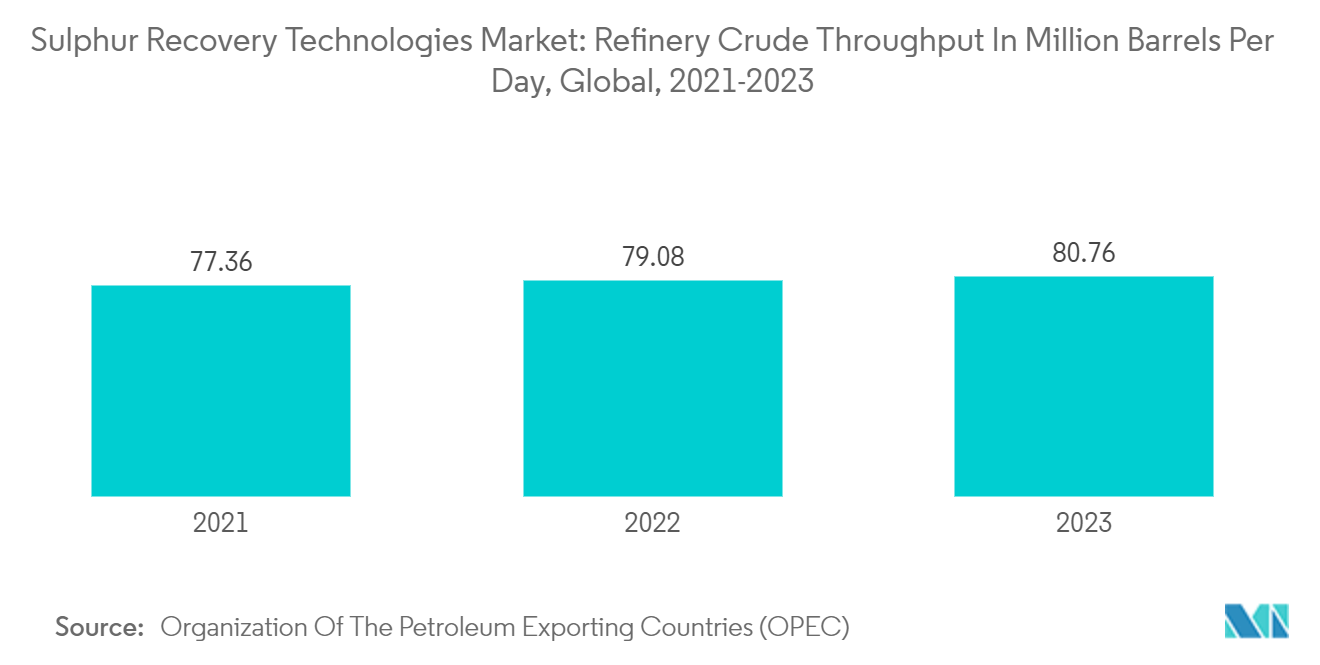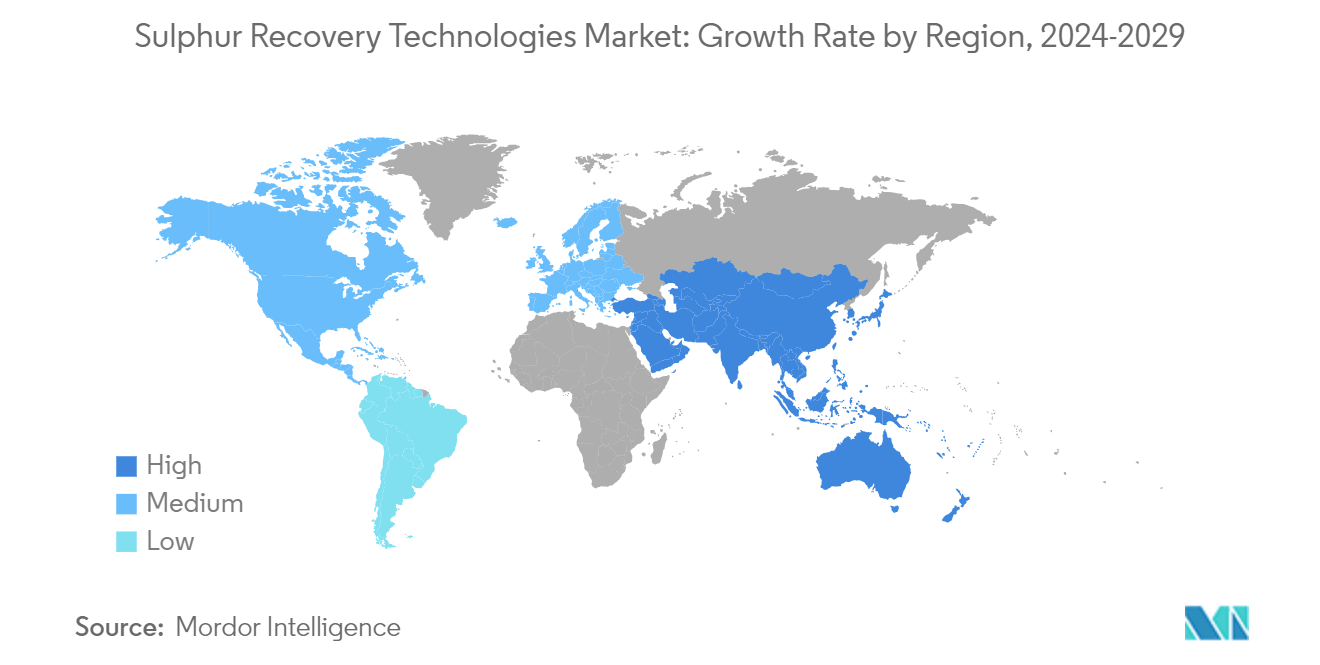Market Trends of Sulphur Recovery Technologies Industry
The Refineries Segment is Likely to Witness Considerable Growth
- Sulfur recovery technologies play a pivotal role in refineries, with the sulfur recovery unit (SRU) being a linchpin for sulfur recovery. Notably, lowering sulfur levels in gasoline and diesel enhances emission controls, subsequently curbing air pollution upon product usage.
- With the rising investments in expanding oil and gas refining plants and the global push for stricter environmental regulations, refineries are poised to maintain their dominance in the future.
- The sulfur recovery unit (SRU) in a petroleum refinery is tasked with extracting H2S from sour gases, a byproduct of various refinery processes, and transforming it into industrial-grade molten sulfur. The predominant method employed in these units, known as the "Claus Process," eliminates a substantial 95-99.9% of hydrogen sulfide from gas streams. In a modified version of the Claus Process, the H2S-rich sour gas is combusted with oxygen, followed by the resulting gas being cooled; molten sulfur is then recovered.
- For instance, according to the Organization of the Petroleum Exporting Countries, refinery crude throughput was 80.76 million barrels per day in 2023 and 79.08 million in 2022. Key contributors to this capacity were the United States, China, India, Japan, Saudi Arabia, and other ASEAN nations. These countries predominantly rely on hydrocarbons and their derivatives.
- Many nations are ramping up their oil refining capabilities, with a focus on technologies like sulfur recovery, to meet future demands. For example, in July 2024, Bharat Petroleum Corporation Limited (BPCL) unveiled plans for a new 12 million metric tons per annum (MMTPA) refinery in India, with an investment of approximately USD 5.98 billion (INR 50,000 crore). The company is scouting locations in Andhra Pradesh, Uttar Pradesh, and Gujarat.
- In June 2024, BPCL announced its ambition to boost its refining capacity to 45 mmtpa by FY 2029. BPCL, which operates refineries in Mumbai, Kochi, and Bina (Madhya Pradesh), boasts a collective refining capacity of about 36 mmtpa.
- BPCL has earmarked around USD 20 billion (INR 1.7 trillion) for investments over the next five years. Of this, INR 75,000 crore is allocated to refinery and petrochemical projects, USD 957 million (INR 8,000 crore) to pipeline initiatives, and over USD 2.4 billion (INR 20,000 crore) to its marketing endeavors.
- Uganda was in talks with an investment firm spearheaded by a member of Dubai's royal family in January 2024. The discussions centered around the development of a planned USD 4 billion refinery for a portion of its crude oil reserves.
- By November 2023, the Sri Lankan cabinet had greenlit a USD 4.5 billion investment from China's energy behemoth, Sinopec. The approval paved the way for Sinopec to set up a new petroleum refinery at the strategically vital Hambantota port.
- Therefore, with the increase in demand for clean fuel, the sulfur recovery technologies market is expected to expand considerably during the forecast period.

Asia-Pacific is Expected to Dominate the Market
- Asia-Pacific covers a wide geographical area and has diverse landscapes, climates, societies, cultures, religions, and economies. More than 50% of the world's population lives in this region. The region is also home to a large number of oil and gas refineries, which are the primary source of sulfur. This resulted in a high demand for sulfur recovery technologies, such as Claus and Tail Gas Treating Units.
- The region is home to a number of emerging economies, such as India and China, which are investing heavily in the oil and gas sector. This has resulted in increased demand for sulfur recovery technologies due to the need to reduce environmental impact. The region is also home to several large-scale petrochemical projects, which require sulfur recovery technologies in order to meet their environmental standards.
- Asia-Pacific is one of the fastest-growing regions in the world, owing to the presence of emerging countries, like India and China, and developed countries, such as Japan, South Korea, and Australia. In 2023, China was the world's second-largest oil consumer and the sixth-largest oil producer. The country imported nearly 50% of its hydrocarbon demand to reduce dependence on imports and improve energy security. Asia-Pacific is one of the significant regions in the sulfur recovery technologies market and is likely to continue its dominance owing to the rapid growth in energy-intensive industries like refineries.
- China has been trying to maximize its shale potential by exploiting its domestic reserves across various inland shale basins, such as the Sichuan Basin. Shale gas development in China has increased steadily over the past few years, recording a growth of 21% annually since 2017. In 2023, China produced 232.43 billion cubic meters of natural gas.
- Sulfur recovery technologies are crucial for India’s oil refining and petrochemical industries to reduce harmful sulfur emissions and produce cleaner fuels. In March 2022, Thermax Ltd, an Indian multinational engineering company, concluded a USD 149.02 million order from an Indian public sector refinery to set up a sulfur recovery block as a part of the Government’s North East Hydrocarbon Vision 2030.
- In February 2024, Malaysia's state-owned Petronas, through Malaysia Petroleum Management, signed production sharing contracts (PSCs) for two discovered resource opportunity clusters with potential gas reserves offshore peninsular Malaysia. The BIGST DRO cluster has an estimated recovery of 4 trillion cubic feet and was awarded to Petronas Carigali and upstream firm JX Nippon Oil and Gas Exploration, each with a 50% participating interest. The cluster is made up of five undeveloped high-CO2 gas fields, namely the Bujang, Inas, Guling, Sepat, and Tujoh fields.
- Hence, Asia-Pacific is expected to dominate the market due to its large oil and gas refining industry and increasing demand for cleaner fossil fuels.


